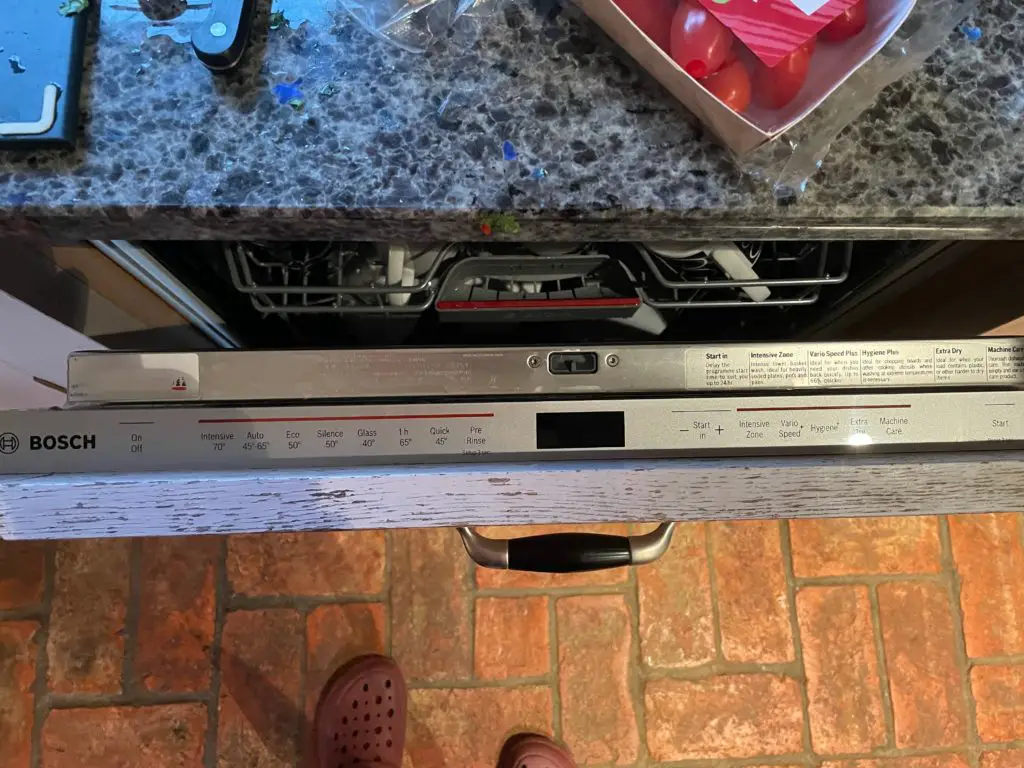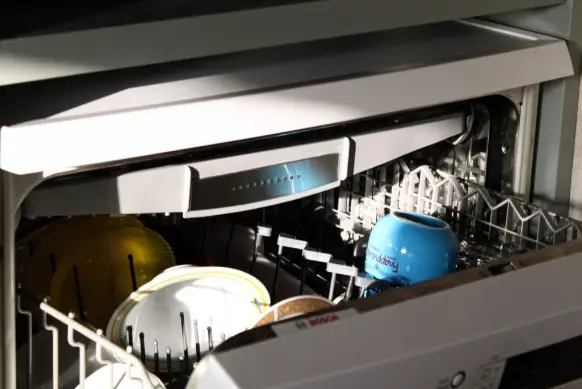The Bosch dishwater has a “check water” light that will flash to indicate that the anti-flood switch is on.
This switch usually means a blocked drain or a broken drain pump, and you might find that there is water leaking from under your dishwasher.
Keep reading to learn what details you can learn from the check water light, how you can fix whatever problem it indicates, and how to reset your dishwater so that the light turns off.
What Does It Mean When Bosch Dishwasher Says Check Water?
The Bosch dishwasher has many lights that help tell its owner what errors or issues the device is experiencing and has fail-safes to ensure that the machine does not continue working as usually only to cause damage to itself or your home.
Bosch’s dishwashers will show a fault by displaying an error number, flashing lights, or both.
These “Check Water” messages can mean:
- Your dishwasher stopped mid-cycle, possibly from a power cut or something else to stop the cycle, and the warning light turns on.
- Error code E22 signals that there is residual water in the sump because of a blocked pump or dirty filter.
- Error code E3 signals that your dishwasher isn’t filling with water. That could be a faulty or stuck valve because of food debris.
- Error code E4 signals that there is a fault water switch.
- Error code E6 signals a faulty Aqua sensor that determines whether the water is dirty or clean.
- The check water light with the rinse aid light signals that the anti-flood switch is on.
- Error code E9 signals a blocked drain or broken drain pump.
- Error code E5 signals that the machine has too much water because of a faulty float switch or water inlet valve.
Rarely will you experience a “check water” light without one of these error codes displaying as well to give you an idea of what is causing issues with your dishwater.
Some problems are easier to repair or solve than others, and some require you to hire a professional to fix them.
What To Do When Your Bosch Dishwasher Says Check Water?
Now that you have an idea of what the light and error codes mean, you can plan how to fix the problem.
Remember that this is by no means an exhaustive list, and if you don’t feel comfortable making repairs yourself, you can always contact a professional to do it for you.
- Power Outage Or Other Mid-cycle Interruption: If you experience a power outage or your dishwasher is otherwise interrupted in the middle of a cycle, you will see the check water light flash. The best way to fix this is to reset the dishwasher or cycle, since there is nothing at fault with the machine itself.
- Error code E22: Error code E22 means either a blocked pump or a dirty filter. You will need to either replace the pump, which may need to be fitted or replace the filter with a new one.
- Error code E3: Error code E3 means a faulty valve, so you need to replace the water inlet valve assembly or check the valve for food debris.
- Error code E4: Error code E4 means there is a faulty water switch, and removing the dishwasher tub needs to happen to access it. You should hire a professional for this job, and you should not attempt this repair on your own.
- Error code E6: Error code E6 means a fault Aqua sensor that a professional should replace for you.
- Rinse Aid light is on: The anti-flood switch is on, which means the dishwasher stops the cycle before flooding can happen. You will need to reset your dishwasher as outlined later in this article.
- Error code E9: Error code E9 means a blocked drain or faulty pump. You will need to replace these to prevent water from leaking from your machine.
- Error code E5: Error code E5 means your dishwasher is overfilling with water, so you need to repair or replace the float switch water inlet valve assembly.
If you choose to make these repairs on your own, then ensure that you are researching the topic, so you repair your dishwasher correctly and seek help if you need it.
How Do You Reset The Check Water On A Bosch Dishwasher?
After you complete the repairs to your dishwasher, or you simply need to start a cycle over, you will need to reset your machine.
To reset your Bosch dishwasher:
- Locate the reset button. Depending on the model, the reset feature is slightly different, but it will have an asterisk and the word “reset” next to it. In several modern Bosch dishwashers, the “Start” button is also the “Reset” button.
- Press and hold the reset button for 3 to 5 seconds.
- Once your dishwasher resets, the drain pump will drain all the water out of the machine.
- After all the water is out, the dishwasher’s display will indicate a “Complete” or “Done” cycle before automatically going into standby mode.
- Try running a cycle. It doesn’t matter which though, you might want to pick a quick or short cycle as you are only testing to see how your dishwasher performs.
- Keep an eye on your dishwasher while it goes through the cycle to ensure it is working correctly. If the Check Water light comes on again or you see some other error, you may need to check your repairs or other faulty equipment.
Tip: On older models where the reset button is called “Cancel” or “Drain,” you will need to follow a specific button pressing sequence, such as pressing the “Wash,” “Rinse,” and “Hold” buttons simultaneously for 3 to 5 seconds with the door closed.
Look up your specific model if you are unsure of the sequence.
Final Thoughts
The Check Water light will flash to let you know that your dishwasher is either filling with water to the point of flooding, or that no water is coming into the machine because of a blocked or faulty valve or switch.
You will need to replace these pieces yourself or hire a professional for more intense repairs in most cases.

I’ve been working with technology in one way or the other all my life. After graduating from university, I worked as a sales consultant for Verizon for a few years. Now I am a technical support engineer by day and write articles on my own blog here in my spare time to help others if they have any issues with their devices.



